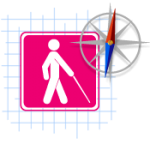

Welcome to the updated, digital version of A Guide to Planning Accessible Meetings, originally published by Independent Living Research Utilization in 1993, written by co-authors June Isaacson Kailes and Darrell Jones. The Mid-Atlantic ADA Center and TransCen, Inc. sponsored this update and publication in recognition of the 25th anniversary of the transformational Americans with Disabilities Act (ADA) of 1990. This version includes regulatory updates along with practical guidance from a host of meeting planning professionals, subject matter experts, and even June Kailes herself. The contents of this guide were developed under a grant from the National Institute on Disability, Independent Living, and Rehabilitation Research (NIDILRR award number 90DP0007). NIDILRR is a Center within the Administration for Community Living (ACL), Department of Health and Human Services (HHS). The contents of this guide do not necessarily represent the policy of NIDILRR, ACL, HHS, and you should not assume endorsement by the federal government. TransCen’s work represents the intersection of grassroots implementation and national policy and initiatives. Since 1996, it has supported the Mid-Atlantic ADA Center, one of ten regional ADA Centers of the ADA National Network, funded by the National Institute on Disability, Independent Living, and Rehabilitation Research. Our goal is that this guide will help make every meeting, event, and conference accessible. It is with great pleasure that we share this work, which will continue to be updated to best serve the needs of planners, and help ensure that all meeting participants are fully engaged and have equal opportunities to contribute to public discourse, learning, and advancement.
This online guide is an update from a print publication issued in 1993. As a web resource, however, it becomes a living document that can be modified and updated as emerging practices become best practices, and as these practices fold into an ever-widening circle of gatherings, both professional and personal. Note that information may be repeated in various sections where it may be relevant. The navigation options on the left of the screen are “chapter” titles, and clicking the link will open both introductory text and additional subchapters with more information and resources. Every effort has been made to ensure that links to other online resources are live and unbroken; staff at the Mid-Atlantic ADA Center will continue to monitor the guide and appreciate hearing from you if broken links are found. Finally, while the ADA is referenced often throughout this document and technical experts have reviewed content, this is not a replacement for competent legal counsel. Rather, the team presents here what is required under the law as understood by these subject matter experts, and promising practices to make YOUR event fully inclusive, a market advantage in today’s competitive and ever-expanding service economy. By ensuring that all participants have equal access, the world will truly be a richer place. A Note on Language and Terms
“Disability advocates strive for equality, accessibility and acceptance, yet they are continually confronted by language which perpetuates negative stereotypes of who they are. People with disabilities, disability rights activists, service providers, health care providers, writers, reporters, editors, educators and supporters must become aware of the power of language. Are you perpetuating negative attitudes and false stereotypes of people with disabilities with your language?”
~ June Kailes, Language is More Than a Trivial Concern Language evolves, often even faster than some of those who speak it. One might hear the phrase, “the disability community,” and think that all people with disabilities use a common language to define themselves and one another, as well as the various accommodations that may be needed for access and inclusion. This is not the case! Often, even well-intentioned and well-informed individuals may fall behind the times and use language that is no longer considered current, respectful, and inclusive. This guide is a living document, and its publishers will attempt to keep it up to date and amended over time. Defining some common terms, and discussing those terms which no longer should be used, is a way to help visitors to the site carry language into the marketplace. Of course, if you are visiting this site and come across terms that are objectionable or offensive to you as a reader, we hope you will share your perspectives so we may consider them for future updates to this guide.
Preparing yourself, your team, and your facilities for meetings, events, and conferences that are accessible to those with disabilities will likely result in delivering even better customer service and a better experience for all attendees. To be better prepared, you will want “soft skills” to support your event in addition to the structural, technological, and other physical elements needed for accessibility. The Guide authors recommend the “Disability Etiquette” resources from the United Spinal Association, which include a comprehensive guide, videos, and downloadable tip sheets in English, Spanish, and Chinese.
In addition to one of the original authors of the 1993 A Guide to Planning Accessible Meetings, the 2015 online guide project team includes subject matter experts from the professional meeting planning and accessible design fields, advocates, and individuals with disabilities across a broad spectrum.
Marian Vessels is the retired Director of the Mid-Atlantic ADA Center. She served in this role for many years, leading the Center’s team in providing training and guidance on the Americans with Disabilities Act. Previously, Ms. Vessels was the Executive Director of the Maryland Governor’s Committee on Employment of People with Disabilities. She also worked as the Director of the Maryland Governor’s Office for Individuals with Disabilities and was an Executive Board Member for the President’s Committee on Employment of People with Disabilities. “I am a wheelchair user who attends many meetings, events and conferences for my job as Director of the Mid-Atlantic ADA Center,” she said. “I often encounter venues, configurations of rooms, food displays, and other aspects of an event that are not welcoming to me as a participant with a disability. Many of these events were disability-related and should have considered these factors when planning and executing their function.” Prior to this project, Marian said there was no current single source to provide guidance and best practices to these planners. “Some of these issues are ADA-related, such as the correct number of properly configured parking spaces, while others are best practices to assure the goal of the ADA — full inclusion of those with disabilities into all aspects of American life — is achieved.” It is the goal of the Center to provide information and resources to further the inclusion of participants with disabilities into the meetings, events, and conferences that you are planning. Please do share this resource with those you feel would benefit from it. We feel that this document will go a long way to provide guidance and tools for more inclusive meetings!
Author and subject matter expert, June Isaacson Kailes, (www.jik.com (link is external) ), is a Disability Policy Consultant and the Associate Director and Adjunct Associate Professor at Harris Family Center for Disability and Health Policy at Western University of Health Sciences, Pomona, California. Her current work focuses on building disability competencies into the worlds of health care and emergency management. June’s breadth and depth of experience in disability, access, and functional needs issues as a writer, trainer, researcher, policy analyst, subject matter expert, and advocate is widely known and respected. “Much has changed since I and Darrel Jones, with the great support of ILRU, first published A Guide to Planning Accessible Meetings in 1993. The writing of that ‘Guide’ was motivated by the authors’ frustration at observing repeated access barriers at meetings and events. The lessons were observed, but often were not subsequently applied.” The Guide proved helpful to making large dents in the problem. “Parts of our ‘Guide’ have been periodically updated and can be found in diverse pieces and fragments on the Internet,” she says. “This NEW online guide centralizes and modernizes accessible event planning information in an easy to use portal, offering dynamic, scalable, and customizable information for planning small to large events, be it conferences, meetings, receptions or dinners. It can be used for getting a thorough orientation to accessible event planning or getting a few very specific answers to access related questions.” As this is a digital guide rather than a published book, June encourages feedback and suggestions from visitors to the site as they use the resources presented.
Kobena works out of downtown Boston for the Massachusetts Rehabilitation Commission (MRC). He is the statewide Coordinator of the federally funded Assistive Technology (AT) Act program in Massachusetts called MassMATCH (Massachusetts Maximizing Assistive Technology in Consumers’ Hands). Kobena is a longtime AT user and enthusiast. He has 20-plus years’ experience using and working with Assistive Technology. His passion is to promote awareness of and affordable access to AT for people with disabilities everywhere. Before coming to work at MRC in 1998, Kobena worked in Toms River, New Jersey for the New Jersey Commission for the Blind and Visually Impaired (CBVI) as a Technological Services Specialist. Among other roles, he conducted AT assessments and made recommendations on appropriate technology to enable CBVI clients to achieve their vocational rehabilitation goals. Between 1999 and 2006, Kobena worked for the Massachusetts Association for the Blind (now MAB Community Services) in three different administrative capacities – NFB-Newsline Coordinator, Director of Communication Services, and Regional Director of MAB’s operations in Western Massachusetts.
Marissa Sanders has worked in disability rights for more than 15 years. She served as Executive Director of the West Virginia Commission for the Deaf and Hard of Hearing and as Director of Training for the Mid-Atlantic ADA Center. She has also worked at three different Centers for Independent Living and served on the National Council on Independent Living. While at the ADA Center, she trained over 500 people on various aspects of the Americans with Disabilities Act. Ms. Sanders currently serves as an independent consultant and as a Video Interpreter for Sorenson Communications where she interprets phone calls in American Sign Language for individuals who are Deaf or hard of hearing. She lives in Charleston, West Virginia with her husband.
Project editor, Angela Strain, has been writing, editing, and presenting education and advocacy materials for more than twenty years in the nonprofit sector, on topics ranging from healthcare to the environment and community organizing. She has helped secure more than $100 million in grant funds for nonprofits across the Southeastern United States. “When the ADA was first passed, the museum system I worked for selected me for training in facility compliance to help advise the team responsible for construction and operation of new attractions, including theaters and education centers,” she says. “From that time to this, advocating for universal accessible design and equal access have been driving passions. This project will help reach a whole new generation of event and meeting hosts, planners, and facilities, with both the letter and the spirit of the law.” She adds, “for me, this work is also personal. With functional needs to be accommodated myself, tackling conferences and meetings can be a challenge; I am eager to see this guide improve the experience of those living with both visible and invisible disabilities and limitations.”
Consultant, trainer, subject matter expert, and president of Meeting Well, Sarah Galbraith Laucks has been planning conferences for people with disabilities since 1993. In fact, her connections to disability go back even further, to the late 1970s when her childhood best friend had intellectual disabilities. Her career includes eight years with Hilton Hotels and five years with Hershey Entertainment & Resorts. Sarah’s varied background has equipped her with skills in conference management, website and email marketing, VIP visits, special events, committee facilitation, and professional speaking and writing. She specializes in access for people with disabilities and eco-friendly initiatives for the meetings industry. “While June Kailes’ guide has been a bible for those of us planning accessible meetings on a day-to-day basis, the professional meeting and hospitality industry is quite large and a majority have not been aware of her work. There’s been a void in the industry’s certification and training programs – no one place for these professionals to turn for answers to their questions, accurate information and guidance on how to make their meetings accessible. Beyond the need to accommodate attendees with disabilities of a certain level, the reality is that many attendees have some type of disability they face. Examples include low vision, hearing loss, dietary needs, food allergies, difficulty walking long distances and temporary, significant disability. Providing tools to make accessible meetings an everyday consideration will serve to take the meetings industry to the next level in producing inclusive, meaningful events.” Sarah holds a Bachelor of Science in education, graduating summa cum laude from Susquehanna University, and is a recipient of the Certified Meeting Professional designation from the Convention Industry Council. Personal interests include animal rescue, nutrition and wellness, and figure skating. She is a member of Pennsylvania Association for Sustainable Agriculture and the Center for Independent Living of Central Pennsylvania Board of Directors.
Formerly a pre-med student, Patrick Florville is an award-winning brand strategist and creative director of Florville Catalyst, Inc., based in New York City. With over 30 years’ experience, he has created branding and communication solutions for an impressive clientele across a broad range of industries, from small businesses and non-profits to Fortune 500 corporations. As a parent of a child with a disability, he brings passion and commitment to organizations and causes which embrace diversity and disability inclusion, empowering them with a compelling presence amidst their largest competitors. Patrick’s work has won national and international awards, and is part of the permanent collection of the Smithsonian Institute National Museum of Design at the Cooper Hewitt.
The Project Team wishes to thank a number of organizations and individuals who have provided input and comment on the creation of this guide, including: Lou Ann Blake, Managing Editor, Journal of Blindness Innovation and Research (link is external) , National Federation of the Blind Lise Hamlin, Director of Public Policy, Hearing Loss Association of America (link is external) Abby Fitzsimmons, Vice President – Membership, United Spinal Association (link is external) Mary Lamielle, Executive Director, National Center for Environmental Health Strategies, Inc.
The Market Case for Accessible Events, Meetings and Conferences While the U. S. Department of Labor estimates that individuals with disabilities control more than $200 billion in discretionary spending, this figure is likely much less than the true market power of all individuals with functional needs to be accommodated. In fact, many Americans who would benefit from a fully accessible meeting, event, or conference environment may not identify their needs as a “disability.” Scroll through the population notes below and see if you don’t find yourself one degree (or less) from someone who may benefit from the promising practices presented in this guide.
While the U. S. Department of Labor estimates that individuals with disabilities control more than $200 billion in discretionary spending, this figure is likely much less than the true market power of all individuals with functional needs to be accommodated. In fact, many Americans who would benefit from a fully accessible meeting, event, or conference environment may not identify their needs as a “disability.” Scroll through the population notes below and see if you don’t find yourself one degree (or less) from someone who may benefit from the promising practices presented in this guide. 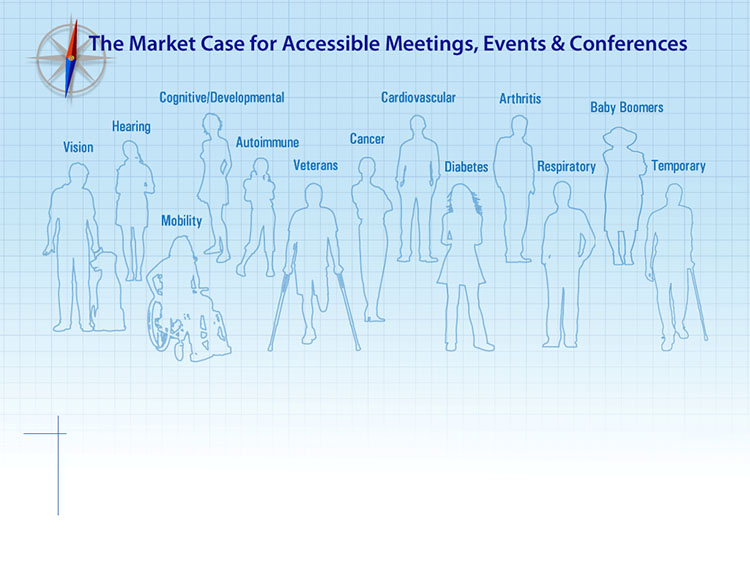
According to the U.S. Census, 57.6 million Americans reported having a disability in the 2010 American Community Survey (published July 2012).
According to the 2012 National Health Interview Survey (NHIS) Preliminary Report, an estimated 20.6 million adult Americans (or nearly 10% of all adult Americans) either “have trouble” seeing, even when wearing glasses or contact lenses, or are blind or unable to see at all (source: the American Foundation for the Blind).
One in eight people in the United States (13%) aged 12 years or older has hearing loss in both ears, based on standard hearing examinations (National Institute on Deafness and other Communication Disorders).
According to the University of Kentucky Human Development Institute, there are approximately 8 million Americans who have some type of mobility impairment that necessitates the use of adaptive equipment such as a cane, crutches, walker, wheelchair, or scooter.
There are 60 million Americans nationwide with learning and attention issues (National Center for Learning Disabilities). The Journal of Pediatrics reports that one in six, or about 15%, of children aged 3 through 17 years have one or more developmental disabilities. The Centers for Disease Control and Prevention (CDC) Autism and Developmental Disabilities Monitoring (ADDM) Network reports that 1 in every 68 children in the U.S. has autism spectrum disorder (ASD).
The National Institutes of Health (NIH) estimate there are up to 23.5 million Americans with autoimmune disorders, including multiple sclerosis, lupus, rheumatoid arthritis, and more.
In 2014, an estimated 1,665,540 new cancer cases were diagnosed (American Cancer Society). In the U.S., 14.5 million children and adults with a history of cancer were alive on January 1, 2014.
Approximately 20% (2,313,600 out of 11,462,900) of non-institutionalized civilian veterans aged 21 to 64 years reported having a service-connected disability in the United States in 2012.
The CDC reports 6.8 million adults diagnosed with Chronic Obstructive Pulmonary Disease (COPD) in the past year, 8.7 million with chronic bronchitis, and 4.1 million with emphysema.
CNN reports 77 million Americans are part of the aging “Baby Boom” generation (born between 1946 and 1964). They represent roughly 24.3% of the total population.
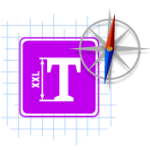
Sites constructed after the ADA was passed should generally meet the ADA’s facility standards. Those standards were updated in 2010, and sites constructed after March 2012 will meet the new 2010 Standards for Accessible Design. (link is external) Sites that comply with the older ADA standards and have not been altered are also considered “accessible.” However, if existing facilities, or parts of them (whether they comply with the older standards or were built before the passage of the ADA) are altered, then the altered areas must comply with the new standards to the maximum extent structurally feasible. Existing facilities that are not altered must still improve accessibility. Private businesses must remove structural barriers where it is “readily achievable” to do so, meaning where it is “easily accomplishable and able to be carried out without much difficulty or expense.” Existing structural conditions, costs, and the financial resources of a particular business must be considered, so what is readily achievable will vary from one business to another. Additionally, since the obligation is ongoing, things that are not readily achievable at a certain point in time may become achievable at a future time. You should always ask about the accessibility of facilities when considering event venues. Not all facility sales representatives will know about the accessibility features of their facilities. Hotels, however, are specifically required to keep detailed information about the accessibility of their properties. This includes public spaces like meeting rooms, restaurants, lobbies, and parking lots, as well as accessible overnight guest rooms and other guest amenities such as fitness rooms or swimming pools. Since hotels must provide this information to potential guests seeking to make reservations, they should have no trouble producing it for meeting planners. Choose facilities that are protected by audible and visible fire alarms and a fire sprinkler system. The U.S. Fire Administration has a list of hotels and motels approved for federal travelers (link is external) which can be helpful in identifying properties that have certain safety features. Facilities that have ground floor meeting rooms with accessible paths directly to the outside are also preferable, as this may allow greater numbers of individuals to evacuate independently. Many meeting planners hire consultants to assess potential event venues, especially for very large or complex events that may involve multiple or specialized facilities. But if you want to assess a facility yourself, the New England ADA Center offers an ADA Checklist for Existing Facilities (link is external) . This user-friendly tool is filled with helpful diagrams and illustrations and includes instructions for use. The checklist contains a basic section that will allow you to review spaces such as parking lots, entrances, and public restrooms, as well as several sections on recreational facilities such as swimming pools and golf courses. You may wish to include an affirmative statement of compliance, or allocation of responsibilities between landlord and tenant, in any rental agreements or contracts you enter with meeting venues. This can help both parties understand their responsibilities, particularly if any temporary measures will be taken to ensure access during your event. This section of the Guide will explore more specific elements of event planning that will help you make your event as accessible as possible.
Before reaching out to facilities to find the best choice for your event, you need to identify the needs of your audience. Here are some things to consider:
Once you have identified your needs and narrowed the venue list to three to five choices, call or email the venue sales offices with your specific requirements and request a proposal. It is important in the initial contact to identify the needs you’ve outlined, as the venue’s responsiveness to your needs in their proposal can be telling.
Create a “scoring system” to help you and your team rank each venue. You can use your Needs Assessment to determine your criteria and decide which items deserve more weight than others. For example, you might decide to rank location over price, or availability of an accessible fitness center over the number of restaurants in the vicinity. Choose a scale that is easy to use and calculate. As in the example below, each team member can be asked to rank each criterion from one to five, with five being best and one being the worst. Compare your team’s rankings to determine the two or three sites you will visit in the selection process.
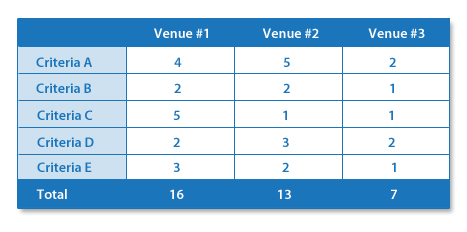
Once you have scored the top two to three venues, you should visit each to continue the evaluation process. When possible, plan at least two visits to each venue. The first visit should be unannounced to the facility’s sales team.
Visit the common areas, have coffee or a meal at a lobby restaurant, walk any of the grounds that are open to the public, assess the parking lot, review access to sidewalks, safety features like call boxes or shuttle service from distant lots, proximity to public transportation, and other “first impression” criteria. You can use your notes from this visit during your scheduled appointment with the venue’s sales team the next time you are on site. If there are concerns that their team cannot fix for your meeting, you will have good information in hand as you make your final choice of location.
Pay attention to your senses during the site visit. Healthy indoor air does not have an odor. Are you aware of fragrances and scents from “air fresheners,” deodorizers, or potpourri? Is your nose or throat burning from chlorine, formaldehyde, or other solvents? Are your sinuses and breathing impacted by mustiness? Even pervasive or lingering cooking odors can be a sign of poor or inadequate ventilation. Note that attendees may have allergies, asthma, sinus problems, frequent headaches and migraines, or chemical sensitivities, and may not be able to successfully participate in your meeting, event, or conference if air quality is poor.
Emergency planning must be done well in advance for all events, and it is important to know that facilities and their staff members are prepared.
During your inspection, be sure to ask about the facility’s emergency procedures and policies related to individuals with disabilities:
Sites should be inspected by you as the meeting planner and by people with disabilities who have a user’s perspective. Ideally, your site selection team will include someone with a user’s perspective who also has knowledge of “cross-disability” access concerns. Don’t assume that someone with a disability understands the access needs of people with other types of disabilities. Make sure your entire site review team is qualified and has the knowledge and experience to evaluate venues for the widest range of needs. An excellent guideline for including individuals with disabilities within your planning team is provided in Effectively Including People with Disabilities in Your Policy and Advisory Groups. (link is external)
If you or your team do not have adequate representation, you may want to reach out to the local Center for Independent Living (link is external) (or other disability subject matter experts, such as the Commission for the Deaf, Blind, etc.) to request a site reviewer to join you on your visit. In determining who will accompany your team, you should determine what gaps your group may have and fill them with expertise in state and federal access codes, Title III of the ADA, and elements of communication access.
Use a site evaluation tool that includes all of the items from your needs assessment. You may wish to use the same checklist that you developed for evaluating the bids received. Be sure to include space for each reviewer to make notes about specific concerns they may have, and plan a group meeting after the inspections to review the team’s findings.
If multiple areas of the property will be used or there are any off-site events planned, the inspection team should visit all sites, including any transportation facilities, to ensure they are accessible. Sites should be reviewed for structural access features, including communication features such as signage and emergency alarm signals.
Once a venue has been selected for your function, make sure the arrangements and terms are spelled out in a contract. Most venues will provide a standard contract that includes your function’s specific details. Review all contracts carefully to make certain that the terms listed reflect your understanding of the agreement. You do not have to accept the contract as written. If needed, you can counter with an alternate agreement and/or contract amendments. For large and/or complex events you should seek legal advice.
In addition to the arrangements and terms specific to your function (the dates, type of space used, number of expected attendees, number of sleeping rooms, etc.) the venue’s standard contract will typically include language about its ADA compliance and responsibilities.
Examine the ADA clauses carefully. Depending on the size and nature of your event you may choose to ask for modifications to the existing contract clauses or request additional clauses. Following are the contract areas most likely to affect attendees with disabilities. Again, these items are provided for information only and should not be viewed as a substitute for legal advice.
The contract should include a clause that indicates that the venue is responsible for complying with the public accommodations requirements of the Americans with Disabilities Act (ADA). Your legal advisor may recommend including language that specifies items such as removal of physical barriers, emergency procedures, access in sleeping rooms and common areas, the provision of auxiliary aids and services, or language about attendees with disabilities receiving service equal to attendees without disabilities.
The “Group” refers to the individual, organization or company contracting with the venue for the meeting, conference, or event. The venue may require a clause that specifies the Group’s responsibilities for making the function accessible. This could include language about setup of exhibits in an accessible manner, provision of certain auxiliary aids and services (e.g., alternate format materials or sign language interpreters) for the Group’s functions, and modification of the Group’s policies, practices, and procedures to ensure that attendees with disabilities can participate equitably in the program.
The Mutual Cooperation clause mandates that the Group shall attempt to identify in advance any needs of attendees with disabilities, and will notify the venue of such needs in a timely manner. Likewise the venue shall notify the Group of any attendee requests for accommodations the venue receives.
Consider including additional clauses that are specific to your attendees needs. For example, if the majority of your attendees are Deaf or hard of hearing you may wish to contract certain requirements, such as the availability of additional communication access equipment (e.g., assistive listening devices).
Likewise, if even a small portion of your attendees have Multiple Chemical Sensitivities (MCS) or environmental illness, consider clauses requiring the hotel to avoid renovations prior to and during your event, use unscented cleaners, and avoid the use of pesticides. The hotel should be asked to comply with the fragrance-free meeting policy for the meeting space, common areas, restrooms, paths of travel, and guest rooms.
National and statewide associations specific to various types of disabilities may be able to recommend clauses to include.
When your meeting, conference, or event will include many attendees with disabilities, it is recommended that you negotiate with the venue and require that they conduct disability awareness training for their staff in advance of your function. The Hospitality and Disability Initiative has customer service training materials that can be downloaded and used for staff training.
Pre-Event Attendee Registration and Communications
Knowing your audience is critical to ensuring that meeting room layouts, menus, and other elements of the event will allow every participant to fully engage. Make sure your registration materials and forms ask specifically about your audience’s needs and accommodations. See the sample below:
To successfully participate in this event, which of the following will you need?
[ ] None – I do not need any modifications to participate
Materials provided in:
[ ] Standard print
[ ] Large print
[ ] Braille
[ ] Electronic Files (formats may include PDF, Word, Text, and Excel)
Communication formats / aids:
[ ] American Sign Language (ASL) interpreting
[ ] Other type of interpreting (please specify; e.g., tactile interpreting): _______________
[ ] CART (Communication Access Realtime Translation)
[ ] Transcripts
[ ] Assistive listening device
I use the following assistive mobility device: ______________
I will be accompanied by a service animal: _____ YES _____ NO
I will be accompanied by a personal assistant: _____ YES ______ NO
I have the following dietary restrictions:
[ ] None
[ ] Vegetarian
[ ] Vegan
[ ] Organic
[ ] Kosher
[ ] Gluten-free
[ ] Dairy/Casein-free
[ ] Sugar-Free
[ ] Other: ________________________________________________________
[ ] Food Allergies/Intolerances (please list): ________________________________________
Other accommodations: _________________________________________________
If meeting planners have questions, the best way to reach me in advance of this event: _______________________________
As attendees to our conference may experience multiple chemical sensitivities, please refrain from wearing all perfumes and use fragrance-free, unscented personal care products for the duration of our event.
Pre-event communications, including promotional and registration materials, should disclose any plans to use flash photography, strobe lights, loud/amplified noise or music, or fireworks. Theatrical fog, chemical air fresheners, and other smells added to spaces can make them inaccessible to those with multiple chemical sensitivities (MCS) or other intolerances.
Keep in mind that every component of your event should be accessible to ALL participants. Make sure pre- or post-event optional tours, social activities, or recreational opportunities are inclusive as well. If an optional activity is not fully accessible, disclose those details in advance so individuals with disabilities have the information needed to determine their interest and ability to participate.
Meeting Room Layouts and Considerations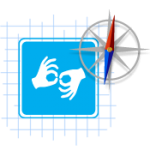
The layout of your meeting, event, or conference will dramatically impact the way attendees engage with your program and with one another. Those who use mobility aids, such as wheelchairs, scooters, walkers, crutches, and braces, require more space to move around. Other accommodations are needed for those with hearing or vision disabilities. This guide provides recommended layouts in a variety of styles that you may print and share with facility staff. Additional considerations, such as audio/visual tools and using a speaker’s platform, are also included.
Keep these recommendations in mind as you plan the layout of seating, tables, and other elements:
Each layout below is available as a printable PDF. You can include layouts as an addendum to your facility contract, provide them in a pre-meeting with facility and banquet staff, and use them with your internal planning team to ensure that your rooms are set up correctly. Measurements shown are adequate for ensuring accessibility, but more space is highly recommended for aisles, paths between chairs and tables, around the perimeter of the room, and around any refreshment or display tables.
Note: these layouts are for meetings where roughly 10% of attendees use mobility devices (wheelchairs, scooters, crutches, etc.) or have a service animal. If your meeting will have more than 10% of attendees using mobility devices or service animals, increase the number of accessible seating locations and aisle widths proportionally.
This set-up is appropriate for large sessions and short lectures that do not require desks or tables for extensive note-taking or frequent reference to handouts. Make sure all side and center aisles are at least three to six feet wide to allow adequate space for circulation. Aisle chairs can be removed in rows dispersed throughout the room to allow seating choices for people who use mobility devices or service animals. At a minimum, remove aisle chairs from the front, back and middle rows to create accessible seating locations. Increase the amount of accessible seating based on the known or anticipated number of people using mobility devices at your event. Remove two chairs for each wheelchair space. Make sure chairs are un-ganged (not hooked together) to allow attendees to move them as needed. Click on the image below for a full-page, printable handout.
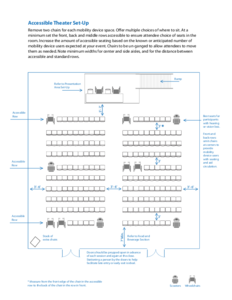 Detail View – Accessible Theater Set-Up
Detail View – Accessible Theater Set-UpRemove chairs to create spaces within rows for people using mobility devices (wheelchairs, scooters, crutches, braces, or other assistive mobility devices). People should not have to sit in aisles. Click on the image below for a full-page, printable handout.
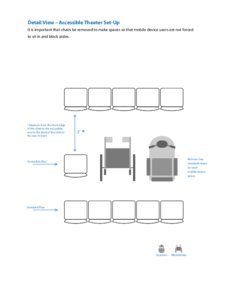
This set-up is very helpful when participants need a surface to take notes and refer to materials. Use the accessible chevron style (next section below) whenever possible, but if space does not allow the chevron, classroom style is an option. Include more than one accessible seating location so attendees have choices. Click on the image below for a full-page, printable handout.
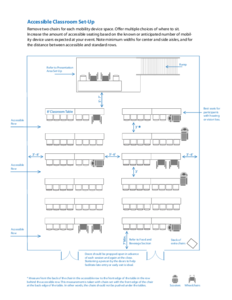
This style of classroom set-up affords the greatest flexibility and space for access. Chevron style allows better line of sight for speakers and attendees and easier entry for those using mobility devices. In either type of classroom plan, remove two chairs for each wheelchair or scooter space. Offer multiple access points and choices of where to sit. It is never appropriate to require that people using mobility devices sit only in the back or in one designated area. Click on the image below for a full-page, printable handout.
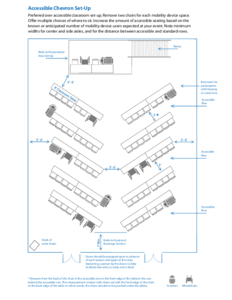
Aisles between round tables require at least three feet of space between the tables (measured from the back of one chair to the back of the chair directly behind it). Side aisles require at least six feet between the table and the side wall or other obstructions. If people using wheelchairs or other mobility aids will be seated at round tables, decrease the number of table settings by one or two to provide adequate space; for a five-foot round table set 8 places maximum, and for a six-foot round table set 10 places maximum.
Note: when possible, use a half-round set-up so that all seats are facing the presentation area, instead of placing seats around the entire table. In that case, a five-foot table could accommodate four place settings, and a six-foot table could accommodate five. Remember that people who use scooters or wheelchairs may prefer to transfer to the chairs at the table and park their assistive devices behind their chairs. Ensure that staff is available to assist as needed. Click on the image below for a full-page, printable handout.
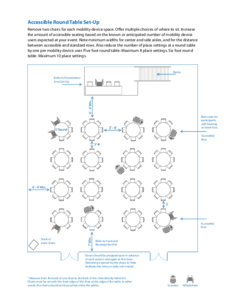
Measure from the back of one chair to the back of the chair directly behind it. Chairs must be set with the front edge of the chair at the edge of the table. In other words, the chairs should not be pushed under the tables. Click on the image below for a full-page, printable handout.
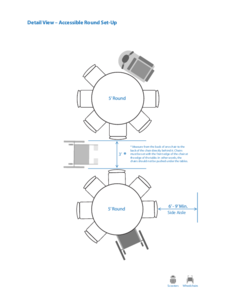
Two layouts are provided here, and either could be adapted for additional presentation elements.
Both layouts incorporate presentation screens that are easily viewed from all areas of the room. Captioning should run on at least one if not all screens showing slides, videos, or live feed of the presenters. Space for a qualified interpreter for people who are Deaf or hard of hearing should be included in all plans, and seating nearest interpreters should be reserved for individuals using those services.
Find out what accommodations your presenters will need for their presentations. Presenters with disabilities may have very specific preferences for microphone type, podium or lectern use, and panel table set-up. The objective is to provide all of your presenters with environments and tools that are comfortable for them.
When possible, offer presenters a choice of microphone type (headset, lavaliere/lapel, table-set, or hand-held) so that presenters can use the type that best meets their needs and preferences.
When working with multiple presenters, take steps to ensure each presenter receives equal status in the presentation environment. For example, if a panel includes four presenters, one of whom uses a wheelchair, be sure to set a space equivalent to two chairs at the panel table for the wheelchair user. If some of the presenters will be using a standing podium, offer a similar option, such as a microphone on a boom stand or a lowered podium, for the presenter who uses a wheelchair.
In no case should a presenter who uses a wheelchair or scooter be asked to present from the floor while others present from a stage. Neither should a presenter using a mobility device be seated at the end of a skirted table instead of with the other presenters. Rather, create an environment where each panelist or presenter is viewed on equal ground with the others. Podiums should be avoided, unless a presenter requests one specifically to accommodate his or her needs.
If slide shows will be used, plan in advance for how they will be managed. You may need to have facilitators who advance slides instead of speakers, or have speakers use remote controls so that they can advance slides from anywhere in the room. This technology is more and more commonly available, though the remote controls vary from vendor to vendor, and some are easier to operate than others. A practice session for each presenter in advance is ideal.
This design shows a stage area with multiple panelists / presenters. Click on the image below for a full-page, printable handout.
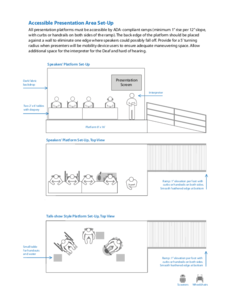
This style is often used for a more conversational presentation, typically with a moderator and one or more guests. Side tables should be provided (for water, notes, or other materials) for each guest. Individuals who use wheelchairs or scooters may need a higher side table than other guests. Click on the image below for a full-page, printable handout.


Make sure your registration process includes questions about specific accommodations registrants may need (please see a list of recommendations for your registration documents in the Pre-Event Attendee Registration and Communication section). Some requests trigger specific responses under the ADA. This guide includes a full discussion of the types of accommodations that may be needed by individuals who are Deaf or hard of hearing, and for those with vision disabilities.
Find out in advance if your facility has any assistive listening systems or devices available, how the meeting room is wired and equipped for sound amplification, and if there are additional costs for accessibility equipment and associated services. Ask if the facility has experience offering Communication Access Realtime Translation (CART) services, or if they have a local contact who can provide this service if needed.
Many individuals who attend your event will neither disclose their need for accommodation nor offer any visible clues to their needs. This is often the case with individuals who are experiencing gradual loss of hearing or vision due to age. For this reason, keep universal access in mind when planning the AV components of your meeting.
There are a variety of strategies and tools, from low-tech to high-tech, for managing audience participation in a large gathering:
Provide guidance for presenters well in advance of your event (also see the section entitled Tips for Presenters).
Slides: These guidelines for PowerPoint or other projected presentation materials are from the National Disability Rights Network:
Videos: Videos should be captioned.
YouTube: YouTube Help provides a list of professional captioning vendors, as well as instructions to add subtitles and closed captions to your own video, either manually or automatically. Be sure to review and edit automatically generated captions. A number of common issues, such as poor sound quality, can cause inaccurate captions.
If there is no way to have a video captioned, it is best not to use it. If a video without captions must be used, a sign language interpreter or speech-to-text service provider may be able to convey the audible content. In such cases, give the service provider ample time to watch the video prior to the meeting.
Handouts and printed materials: Printed materials may need to be converted to accessible formats for people who are blind or have low vision. Since it can take up to 30 days to create these accessible formats, make sure you require presenters to send you their materials far enough in advance to make this possible.
Food and Beverage Service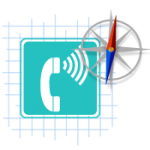
The Food Service: Accommodating Diners with Disabilities (link is external) factsheet provides both legal standards and promising practices for paths of travel, approach to dining spaces, seating, dining table and service counter heights, and other tips for making meal and break areas as accessible as possible.
Buffet meals can work for all audiences, though additional time may be required (versus seated/served meals). Use the following guidelines when setting up buffet lines and stations:

According to FARE (Food Allergy and Research Education) “Fifteen million Americans have food allergies – and they are eager to find restaurants [and other venues] that can accommodate their needs.”
The number and variety of special diet requests has grown significantly in recent years. These needs include attendees with food allergies and intolerances, as well as those on special diets for medical, health, religious, or other reasons.
Dietary needs can include avoiding common allergens (milk, soy, egg, wheat, peanuts, tree nuts, fish, and shellfish) as well as vegan, vegetarian, organic, kosher/kosher style, and any number of “free” diets (free of gluten, sugar, fat, etc.).
Collect information about your attendee’s dietary needs during the registration process. It’s the responsibility of attendees to notify you of their needs in advance so you can make appropriate plans. Here is a sample of what this section might look like in your registration materials. Include a “none” option. Include a specific question about food allergies and a space for attendees to list other needs.
I have the following dietary restrictions:
[ ] None
[ ] Vegetarian
[ ] Vegan
[ ] Organic
[ ] Kosher
[ ] Gluten-free
[ ] Dairy/Casein-free
[ ] Sugar-Free
[ ] Other: ________________________________________________________
[ ] Food Allergies/Intolerances (please list): ________________________________________
Share this information with the catering staff for your function and develop a plan to provide attendees with food items that meet their needs. Chefs are increasingly experienced and comfortable in accommodating guests with special diet requests. Consider providing attendees with tickets or index cards that specify their particular diet for each meal, so service staff can easily identify and serve them appropriately.
Original Publication: National Law Review, March 9, 2015; Reposted with Permission of the Author
Restaurants nationwide are beginning to offer gluten-free alternatives to regular menu items. This is welcome news to those long suffering from celiac disease, a chronic and serious immune reaction to eating gluten, a protein that is found in wheat, barley and rye. The National Foundation for Celiac Awareness cites a statistic that one out of every 133 Americans has celiac disease. While that number seems small, that means that a busy restaurant will likely encounter at least one customer with celiac disease every few days at the least, and quite often daily. Many restaurants that do provide gluten-free options, however, charge an added fee for the dish. This raises a few important topics of note for those with celiac disease – whether celiac disease is a “disability” that requires accommodation under the American with Disabilities Act (“ADA”), whether a restaurant must provide a gluten-free dish as an accommodation, and finally, whether it may charge an added fee for the accommodation.
Title III of the ADA prohibits discrimination on the basis of disability in the activities of places of public accommodations. Restaurants open to the public fall squarely within this rule, for instance. A disability under the ADA is any mental or physical impairment that substantially limits a major life activity. As to whether celiac disease is considered a disability for ADA purposes, the Justice Department of Justice (“DOJ”), the department in charge of enforcing Title III of the ADA, has already answered in the affirmative. In 2012, the DOJ entered into a settlement with Lesley University, a college in Cambridge, MA that requires the college’s meal plan to provide gluten-free and allergen-free food options.
As to the question of whether all public accommodations must serve gluten-free food, the DOJ has an answer as well: No. The meal plan at issue in the Lesley University situation was a mandatory meal plan for all students living on campus. Students were required to eat the food, so the ADA required a reasonable modification to the plan to accommodate students with celiac disease. While colleges with meal plans should take note of this circumstance, restaurants that serve the public aren’t under the same obligations. Populations that have ready access to other sources of food aren’t likely to fall under the same requirement as the college at issue here.
Finally, the question now becomes whether restaurants that do serve gluten-free alternatives and charge an extra fee for them are in violation of the ADA for charging those with celiac disease a premium. This is the subject of a current California class-action lawsuit against P.F. Chang’s, which offers gluten-free food for a $1 surcharge. The argument behind the lawsuit is that the added surcharge has a discriminatory effect against those with the disease. Some commentators have likened this to installing a wheelchair ramp and charging for the privilege of using it. The restaurant chain has defended the practice, stating that the higher costs of specialty ingredients and separate preparation areas necessitate the added surcharge.
Accommodations for Deaf Individuals or Those Experiencing Hearing Loss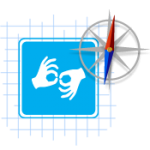
Auditory and spoken information needs to be accessible to people whose disabilities affect communication, including people who are Deaf or hard of hearing and those with speech disabilities. One in eight people in the United States (approximately 30 million) age 12 or older has hearing loss in both ears, according to the National Institute on Deafness and Other Communication Disorders (NIDCD). Millions more have difficulty with voice, speech, and language.
Individuals with hearing disabilities cover a broad spectrum, from mildly hard of hearing to profoundly Deaf. People who are hard of hearing often rely on their hearing to access auditory information, and request technologies such as assistive listening systems and devices to focus and amplify targeted sounds and overcome background noise. They may also use Communications Access Realtime Translation (CART) or captioning. Individuals who are Deaf tend to rely on their vision to access auditory information, and may use captions, CART, and sign language interpretation.
Individuals who are deaf-blind use their sense of touch to access information. They may request such accommodations as tactile sign language interpreters, Braille materials, and tactile signage.
People who have both low vision and hearing loss may request close vision interpreters (interpreters positioned very closely to the person using the service), large print materials, and/or assistive listening devices.
People with voice, speech, and language difficulties may use a variety of accommodations to express their thoughts, such as typing on a computer or text device, using a speech device, and/or using an interpreter to voice for them.
This section will provide information and tips to ensure that individuals with disabilities that affect communication are given full access to meetings and meeting facilities. Information about telephones, video presentations, and remote meetings is included.
Event and facility staff should receive guidance and training on how to interact with your attendees (see customer service training materials). The following information will help improve communication between host staff and individuals who are Deaf or hard of hearing:
As people age, the likelihood they will experience hearing loss increases. Elders who are beginning to lose their hearing may need accommodations for the first time in their lives. Many people are embarrassed and don’t want to ask for help, or may be unaware that help is available. Most people who lose their hearing later in life do not learn sign language. For these individuals, the most useful access tools may be assistive listening systems and devices, speech-to-text technologies or services (such as CART), and captioning for videos. Captioning videos is an effective practice even when it has not been specifically requested.
Additionally, it is best to have everyone speaking in a meeting use a microphone whenever possible. This helps everyone hear what is being said.
Many people with hearing and speech disabilities use sign language as their primary means of communication and use interpreters to communicate with people who don’t sign. Interpreters are professionals who must be qualified. The ADA regulations define a qualified interpreter as one who is “able to interpret effectively, accurately, and impartially, both receptively and expressively, using any necessary specialized vocabulary.” In some states, interpreters are also required to hold specific qualifications or certifications, either developed by the state or through the national Registry of Interpreters for the Deaf (RID).
Many professional interpreters are hired through interpreting agencies, but others work independently, or freelance.
In most cases it is not appropriate to use an individual’s family or friends to interpret at a meeting. Unless an individual specifically requests that a friend or family member interpret, and state law allows it, the ADA regulations say that an individual’s companion may only be relied on to interpret in two situations: 1) in an emergency involving an imminent threat to the safety or welfare of an individual or the public where a qualified interpreter is not available, and 2) in a situation not involving a threat where the individual requests that an accompanying adult interpret, and that adult agrees.
When hiring interpreters, ask them to refrain from wearing or using fragrances and scented personal care products, including perfumes and colognes, scented soaps and lotions, body sprays, after-shave, scented hair care products, scented deodorant, scented laundry detergents, fabric softeners, etc.
There are several types of interpreting, and it is important to ask individuals which type they need. You may need to provide multiple types of interpreters for multiple individuals. Types of interpreting include:
Consider the following factors when hiring interpreters for a meeting: